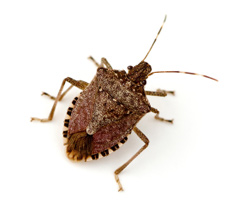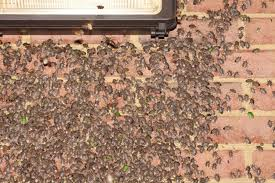The “Stink” on Stink Bugs
The most common stink bug found in Virginia is the Brown Marmorated Stink Bug. They can be various shades of brown, and have a shield-like shape, which is common to all stink bugs. They are primarily considered agricultural pests, but can also infest people’s homes, especially in rural areas.
 Non-native Pests: Stink bugs are native to China, Japan, Korea, and Taiwan, and were accidentally introduced into the U.S. in 1998, in eastern Pennsylvania. They are mostly found along the eastern part of the country, and in 2010, higher than normal numbers were reported. This is suspected to be caused by the recent unusually warm springs and summers. While normally there is one generation produced per year, these warmer temperatures have allowed 2 or 3 generations to be produced in a single year. This has caused even greater problems for farmers, destroying large amounts of their crops.
Non-native Pests: Stink bugs are native to China, Japan, Korea, and Taiwan, and were accidentally introduced into the U.S. in 1998, in eastern Pennsylvania. They are mostly found along the eastern part of the country, and in 2010, higher than normal numbers were reported. This is suspected to be caused by the recent unusually warm springs and summers. While normally there is one generation produced per year, these warmer temperatures have allowed 2 or 3 generations to be produced in a single year. This has caused even greater problems for farmers, destroying large amounts of their crops.
Non-picky Eaters: Stink bugs will eat just about everything, including all fruits and vegetables, as well as flowers, leaves, and other crops. They also eat other insects, such as caterpillars. They eat by piercing the plant with their mouth and sucking out all the juices. This feeding results in dimpled or rotting areas on the surfaces of fruits, stippling on leaves, loss of seeds, and the possible transmission of disease causing microorganisms to other plants.
 The Stink: Stink bugs are known for the nasty smell they produce when they are threatened or mishandled, which is a defense mechanism evolved to prevent them from being eaten by birds and lizards. This smell can be irritating to the eyes and nose of humans, and a direct spray into the eyes can cause great pain. Pain can also occur for people who have allergies or nasal problems, which may result in hospitalization. Therefore, do not crush stink bugs when trying to get rid of them!
The Stink: Stink bugs are known for the nasty smell they produce when they are threatened or mishandled, which is a defense mechanism evolved to prevent them from being eaten by birds and lizards. This smell can be irritating to the eyes and nose of humans, and a direct spray into the eyes can cause great pain. Pain can also occur for people who have allergies or nasal problems, which may result in hospitalization. Therefore, do not crush stink bugs when trying to get rid of them!
Reproduction: Female stink bugs can lay up to 130 eggs at a time, and lay them in rows of clusters on leaves, stems, and pods. The eggs are initially white, but turn pink when they are close to hatching. Nymphs (immature form of insects before they reach reproductive maturity) are smaller than adults, but similar in shape. They molt through 5 stages before becoming adults, and gain wings through these stages. The entire life-cycle takes four to five weeks.
 Winter Hibernation: In the fall stink bugs begin to appear in peoples’ homes, as they are seeking a nice, warm place to shelter and lay eggs over the cold winter months. Since they are attracted to light and warmth, peoples’ homes can be a very attractive place to hibernate. Additionally, they gather in groups when they hibernate, so if one is seen, that is an indication that there are many more. Even though they enter homes for hibernation, the home may be warm enough to cause them to remain active, and they are usually found flying around light fixtures.
Winter Hibernation: In the fall stink bugs begin to appear in peoples’ homes, as they are seeking a nice, warm place to shelter and lay eggs over the cold winter months. Since they are attracted to light and warmth, peoples’ homes can be a very attractive place to hibernate. Additionally, they gather in groups when they hibernate, so if one is seen, that is an indication that there are many more. Even though they enter homes for hibernation, the home may be warm enough to cause them to remain active, and they are usually found flying around light fixtures.
Spring Re-awakening: Once winter is over and the weather begins to warm up, the stink bugs that had been overwintering in the home emerge and make their way outside and into the yard. The earlier it begins to get warm, the earlier one can expect to see them reappear. Stink bugs also release chemicals that attract more of their own kind to attractive locations. This, in addition to the fact that they have very few natural predators, allows their populations to explode. Unfortunately, general pest treatments will not target stink bugs, and therefore they must specifically be treated for by a pest control provider.


































































